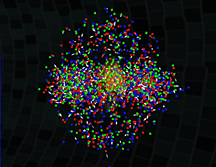- Number 305 |
- February 15, 2010
New details of hot quark-gluon soup

RHIC's quark-gluon plasma
Recent analyses from the Relativistic Heavy Ion Collider (RHIC) at Brookhaven Lab establish that collisions of near-light-speed gold ions create matter at a temperature of about 4 trillion degrees Celsius — the hottest temperature ever reached in a laboratory and 250,000 times hotter than the center of the Sun. That’s hot enough to melt protons and neutrons into a plasma of quarks and gluons — a substance that last existed some 13 billion years ago, a mere microsecond after the Big Bang. New findings also suggest that “bubbles” formed within this hot soup may internally disobey fundamental symmetries that normally characterize the interactions of quarks and gluons. These first hints of symmetry violations at RHIC suggest that scientists may now have a unique opportunity to test in the laboratory some crucial features of symmetry-altering bubbles speculated to have played important roles in the evolution of the infant universe.
[Karen McNulty Walsh, 631.344.8350,
kmcnulty@bnl.gov]
